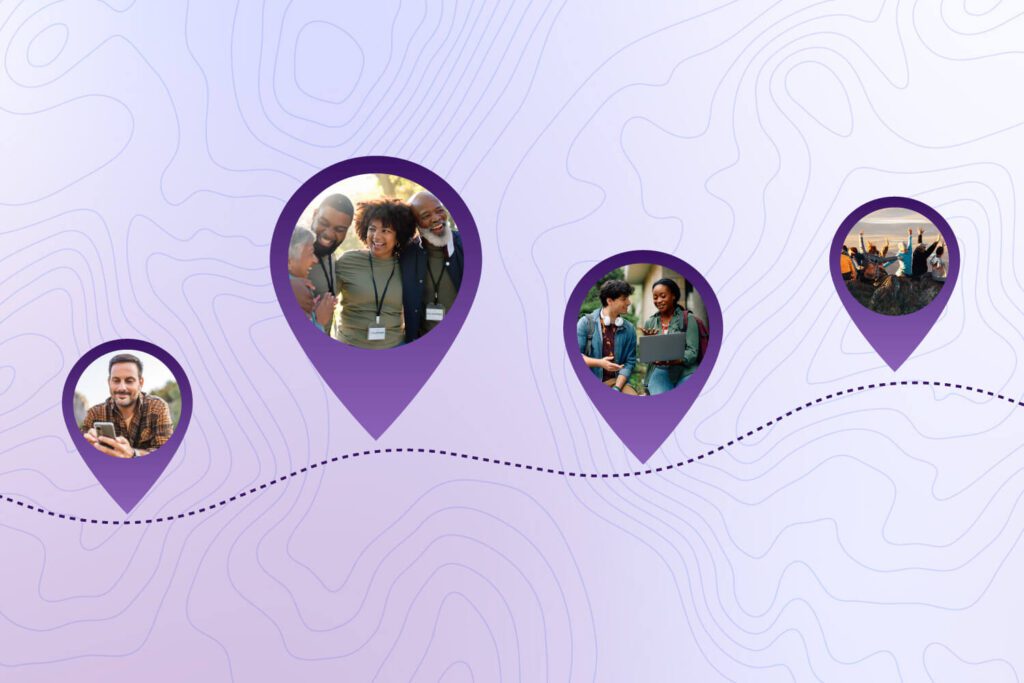Planning an advocacy campaign: The comprehensive guide

Advocacy campaigns are a key way social good organizations can drive progress. They call attention to pressing issues, identify solutions, coordinate community efforts, and offer a useful way to bring about changes that make our world a better place.
This article provides several best practices and pieces of practical advice that nonprofit organizations need to plan and execute a successful advocacy campaign. Let’s get started!
Advocacy campaign FAQs
Organizations new to advocacy will likely have several questions about the process. Here are a few essentials you should know before starting your own campaign:
What is an advocacy campaign?
An advocacy campaign is a local, state, or national effort that uses one or more advocacy tactics to spread the word about a specific issue and organize supporters to take action.
An example of an advocacy campaign might be an organized effort to pass a new state law requiring schools to offer universal preschool programs. Another example might be creating a petition to stop local businesses from using styrofoam containers for their take-out orders. In both cases, an advocacy campaign involves defining the problem, identifying a solution, sharing the message with supporters, and working to create lasting change.
Why are advocacy campaigns important?
Advocacy work is often the catalyst for change in important policies at the federal, state, and local levels. It seeks to ensure that all people have their voices heard and rights protected.
Advocating for a specific solution to a specific problem also helps to raise awareness for your cause and inspire supporters to further their involvement with your organization. Additionally, advocacy campaigns are a great way to build your email list, motivate supporters to get involved in your work and raise funds to further your purpose.
Which organizations use advocacy campaigns?
There are several different types of organizations working to effect change. Some groups are focused entirely on legislative efforts, such as changing laws, meeting with legislators, and advocating for specific bills. This is typically called lobbying.
Individuals and nonprofit organizations that work to change laws and affect policy fall under the general category of activism. Activism is rallying supporters around a cause, educating them on a specific issue, and asking them to take action in support of that cause. These actions can include writing a letter, signing a petition, sending social media messages, making phone calls, and donating.
Within the IRS’s definition of tax-exempt organizations, there are several designations that can effect socio-political change:
- 501(c)(3) organizations: Nonprofit organizations advocate for the causes they serve, which are outlined in their mission or statement of purpose. These organizations can lobby as well, but the number of hours they can lobby and the type of support they can provide for a cause is regulated by federal tax law.
- 527 organizations: These organizations are tax-exempt and operate with the specific purpose of influencing elections by either advocating for or against certain candidates.
- PACs: Political action committees (PACs) gather funding from members and donate to campaigns to either help elect a candidate or keep a candidate out of office. There are typically caps on how much money a PAC can contribute.
- Super PACs: Super PACs can raise unlimited funds to advocate for or against certain candidates. They cannot, however, directly coordinate with or donate funds to a candidate. That means they must operate independently of the candidate and cannot communicate with that candidate during their campaign.
Although advocacy groups are varied in their work, they share a common goal of effecting change.
What activities comprise advocacy?
Advocacy activities are the methods of communication you use and the actions you ask your supporters to take in your advocacy campaigns.
Here are a few popular tactics that are implemented in successful advocacy campaigns:
- Online petitions: An online petition introduces an important issue and includes a form where supporters can express their agreement. When the form is completed, you receive the signer’s contact information so that you can continue communicating with them later.
- Targeted messages: Encourage supporters to send messages to policymakers through the forms on your site. These messages should be targeted to an individual policymaker or group of legislators and have specific language that will resonate with their intended audience.
- Social media advocacy: Use social media to spread awareness for your advocacy campaign through text, links, videos, graphics, GIFs, and more.
- Click-to-call: Include a link on your website or advocacy campaign pages to automatically connect users with their elected representatives. Then, provide a script that supporters can follow when on the phone with their legislators.
- Legislator lookups: Supporters can use this search tool to find elected officials that represent their districts (or other decision makers) and send them targeted messages.
- Action alerts: Email (or text!) your supporters when an important development takes place in your campaign. The intent here is to channel a sense of urgency and move supporters to immediate action.
- Event registration: Well-planned events can bring new supporters into the fold, educate them on the actions you want them to take, and raise funds for your cause. This can include training, in-person or online events, conference calls, or webinars.
- Online fundraising: Embed fundraising forms on your site, so supporters and advocates can donate to the cause, directly furthering your advocacy efforts.
- Texting: Use text messaging to get the word out, send links to supporters, and even fundraise via special shortcodes and online forms.
- Facebook Lead Ads: This is a special type of ad used in Facebook feeds that, when clicked on, allows visitors to submit their information. The information is then downloadable or synced to your CRM automatically.
Each of these tactics can be performed using advocacy software that automates the advocacy campaign process and helps you communicate directly with the targets of your campaign.
Five steps for planning an advocacy campaign
1. Set a goal
The first step in any advocacy campaign is defining what success means to your organization. For example, do you want to educate the public about a previously unknown issue, influence policy change, or raise money to power a charitable purpose?
Create an achievable and aspirational objective that can be measured so you can track progress and inform supporters when you’ve reached the finish line.
Here are a few examples of effective advocacy goals an environmental justice group might use:
- Receive 500 signatures on a climate action petition by June of this year.
- Encourage three Congress members to sign on to the climate action plan before the end of the year.
- Get a climate action bill signed into law before the end of the next congressional session.
These goals are specific and actionable. Whether or not they’re realistic will depend on whether you believe they can be achieved through your organization’s existing supporter base and resources. If your organization only has five consistent supporters, getting 500 signatures may be out of reach. If you have 20,000 supporters, getting 500 signatures may be a simple task.
2. Identify the target
The target of your advocacy campaign will be the person or people who are able to bring about the change defined in your campaign goal. This could be a body of people—like getting a majority of your state senators to pass a bill—or an individual—such as persuading the owner of a local restaurant to use biodegradable straws.
When you’ve found the person or people to target, you want to create a target profile to better understand who they are and how they make decisions.
Begin by asking questions like:
- Who are their supporters?
- How old are they?
- What is their professional background?
- Where do they live?
- What are their values?
- What is their worldview or what are some of their general beliefs?
- What policies have they supported and opposed in the past?
Understanding this information will help you create effective advocacy campaign messaging that spurs your supporters to action.
3. Build your team
Each advocacy campaign team should have the following team members:
- Campaign admin: The administrator serves as the main point of contact for questions and is responsible for making sure the rest of the team performs their duties on schedule.
- Campaign marketer: The head of marketing creates targeted messages with input from other team members. They might also create graphics, film videos, place ads, set up website pages, and work within the advocacy software.
- Volunteer coordinator: The volunteer coordinator interacts with campaign supporters and volunteers, helps train them in their roles, makes sure they understand the campaign messaging, and encourages them to share the campaign with friends and family.
Of course, every advocacy campaign will need supporters in the form of members of the public, petition signers, action-takers, callers, and so on. You might also supplement your campaign team by building coalitions with additional people who can influence your target. This might include other elected officials, concerned parents, and local experts on your advocacy campaign’s subject matter.
There is no limit to the number of team members for your individual campaigns. However, it helps to keep group dynamics in mind. The team should be skilled enough to make decisions quickly and get the message out to your intended audience.
4. Define your message
Once your advocacy campaign team is in place, create the messages that will be used to engage your supporters and ultimately reach the campaign target. A complete campaign message has two parts: a defined problem and a proposed solution.
Start by defining the problem or calling attention to the issue. This is essentially your goal written out in a narrative form. Describe the problem in detail and explain why people should care.
Consider how Tobacco-Free Kids uses key statistics to motivate their audience to quit smoking:
Half of all kids who try smoking start with menthol cigarettes. And because of the tobacco industry’s targeted marketing, 85% of Black smokers now smoke menthol cigarettes, compared to less than 10% in the 1950s. Menthol cigarettes are a major reason why Black Americans have a harder time quitting smoking and are more likely to die from tobacco-related diseases like lung cancer, heart disease, and stroke.
After you define the problem, describe the solution and what the world would look like if your solution is achieved. Here’s an example of how you can define the desired action and the path to your recommended solution:
If we get 500 signatures on our climate action petition, your local commissioners will pass our climate action resolution, prohibiting the use of styrofoam containers for take-out food orders. This change could help our community reduce trash on our streets by 25%, and reduce stormwater backups due to clogging by 10%.
With the defined problem and a proposed solution, you can then map out a timeline and determine the tactics that will make the most impact.
5. Map out a timeline
Your overall advocacy campaign should have a timeline during which you expect to complete your intended goals.
Be mindful of the time it takes your team to create the required messaging to move people to action. Take the previous planning steps into account and discuss the most appropriate timeline with your team. Leave room for changes, edits, discussions, and questions from supporters.
Advocacy campaign examples that inspire
Before planning your own campaign, consider how these advocacy campaign examples effectively brought about change and completed their intended goals:
Save the Children Action Network – High 5 for Kids Campaign
In 2020, Save the Children Action Network (SCAN) launched High 5 for Kids, an advocacy campaign that urges political candidates to invest in the health, safety, and education of children.
With a strong digital advocacy strategy, SCAN advocates were able to engage more than 37,000 Colorado voters and make history for Colorado kids with the passage of a statewide ballot measure to secure funding for universal preschool. Now, every 4-year-old in Colorado has the chance to attend preschool.
Food Allergy Research and Education (FARE) – Sesame Campaign
Sesame is the ninth most common food allergy among children and adults in the United States, and the FDA does not currently require it to be present on food labels. But that’s changing because of the advocacy done by FARE.
FARE advocated for the FDA to require food products that contain sesame to be labeled through tactics like in-person visits with members of Congress, coalition building, and online education. In early 2021, Congress passed their bill, and it is in the implementation process now.
CT Against Gun Violence (CAGV) – Connecticut Initiative to Prevent Community Gun Violence
CT Against Gun Violence (CAGV) has pursued a multi-dimensional strategy to reduce gun homicides that disproportionately victimize communities of color. CAGV uses Salsa to engage supporters, encourage contact with local and statewide legislators, and support its programs and initiatives.
CAGV’s proposed “Connecticut Initiative to Prevent Community Gun Violence” was recently given a boost by the state governor who announced spending an additional $3 million on community gun violence prevention programs, funded by the Biden administration’s American Rescue Plan Act passed by Congress in 2021.
Software to power your advocacy campaigns
Winning the campaigns of the future requires strategic, centralized leadership combined with an autonomous and empowered grassroots base, all backed by technology that supports multi-channel advocacy tactics.
Exceptional advocacy software will include all the advocacy tactics discussed in this article and provide additional best practices for building a multi-channel grassroots advocacy campaign.
The right software can amplify your voice by rallying your supporters around an important issue and giving them tools to effect change. Whether it’s social justice, legislative change, or regulatory compliance, understanding what they’re interested in and presenting relevant content is the key to driving commitment to your cause.
Next steps: Launch your own advocacy campaign
Whether you’re part of a growing grassroots movement or an established lobbying firm, an advocacy campaign has the power to enact meaningful change. Now it’s your turn to send updates on policy issues, coordinate rallies, and make the world a better place.
READY TO GET STARTED?
Work with Bonterra



